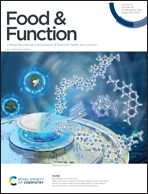Daidzein alleviates doxorubicin-induced heart failure via the SIRT3/FOXO3a signaling pathway†
Abstract
Heart failure (HF) is a clinical syndrome characterized by typical symptoms that usually occur at the end stage of various heart diseases and lead to death. Daidzein (DAI), an isoflavone found in soy foods, is widely used to treat menopausal syndrome, prostate cancer, breast cancer, heart disease, cardiovascular disease, and osteoporosis, and has anti-oxidant and anti-inflammatory properties. However, the effects of DAI in HF remain unknown. In this study, doxorubicin (DOX) was used to establish HF models of C57BL/6J mice and H9c2 cells with DAI treatment. Our results showed that DAI markedly improved the DOX-induced decline in cardiac function, and decreased the left ventricular ejection fraction, cardiac inflammation, oxidative stress, apoptosis, and fibrosis. Mechanistically, DAI affects cardiac energy metabolism by regulating SIRT3, and meets the ATP demand of the heart by improving glucose, lipid, and ketone body metabolism as well as restoring mitochondrial dysfunction in vivo and in vitro. Additionally, DAI can exert an antioxidant function and alleviate HF through the SIRT3/FOXO3a pathway. In conclusion, we demonstrate that DAI alleviates DOX-induced cardiotoxicity by regulating cardiac energy metabolism as well as reducing inflammation, oxidative stress, apoptosis and fibrosis, indicating its potential application for HF treatment.



 Please wait while we load your content...
Please wait while we load your content...